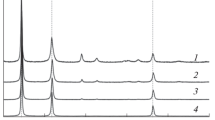Summary
Strongly conglomerated molybdenum powder may be produced by reducing molybdenum oxides in hydrogen by the following two methods.
-
1)
Reduction of coarse-grained molybdenum dioxide in humid hydrogen in a furnace with moving boats at a temperature of 900°C. In this case, the yield of the middle fraction of conglomerates (particles −71 + 40μ in size) having a bulk density of 1.04 g/cm3 and the same purity as grade MCh powder is about 33%.
-
2)
Reduction of coarse-grained molybdenum dioxide with dried hydrogen in a stationary muffle furnace at 1400–1500°C for 5–6 hours. The yield of conglomerates −71 + 40μ in size, with a bulk density of 1.77–2.14 g/cm3, attains 35%; this may be increased by 10–12% by crushing the coarse fraction of conglomerates.
Similar content being viewed by others
Literature cited
G. A. Meerson and A. N. Zelikman, Metallurgy of Rare Metals [in Russian] (Moscow, Metallurgizdat, 1955).
C. J. Smithells, Tungsten [Russian translation] (Moscow, Ferrous and Nonferrous Metallurgy Press, 1958).
Author information
Authors and Affiliations
Rights and permissions
About this article
Cite this article
Koryakin, I.V., Bobkova, N.N. Conditions of preparation of conglomerated molybdenum powder. Powder Metall Met Ceram 3, 109–112 (1964). https://doi.org/10.1007/BF00774479
Received:
Issue Date:
DOI: https://doi.org/10.1007/BF00774479




